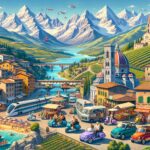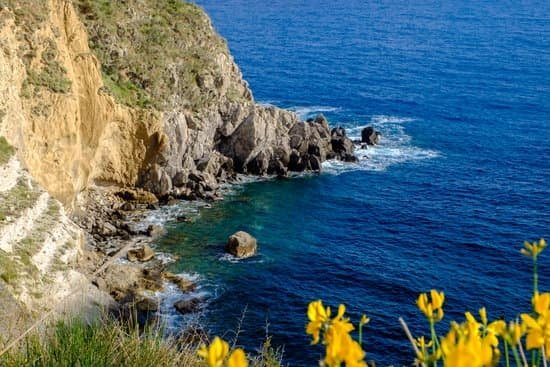Embark on a journey through Italy’s diverse landscapes, captivating culture, and rich history as we explore the enchanting regions of this beautiful country. From the majestic Italian Alps in the North to the sun-kissed shores of the Amalfi Coast in the South, each region offers its own unique attractions and experiences. Discover why every corner of Italy is worth visiting and how long it would take to travel to every region in this stunning Mediterranean destination.
Italy is renowned for its geographical diversity, boasting a range of landscapes from snow-capped mountains to rolling hills and coastal plains. The country is composed of 20 distinct regions, each with its own traditions, cuisine, and historical significance. From the bustling cities of the North to the idyllic countryside of Central Italy and the alluring islands in the South, there is something for every traveler to discover in this remarkable country.
Join us as we delve into the unique characteristics that make each region special, from exploring charming lakeside towns in the North to soaking up the Mediterranean lifestyle in Sicily. Learn about practical tips for planning your trip and budgeting for an unforgettable adventure through Italy. With so much to explore and experience across this diverse land, you won’t want to miss out on any part of it.
The North
For those who appreciate stunning mountain vistas and outdoor adventures, the Italian Alps in the northern region are an ideal destination. Whether it’s scaling peaks or enjoying leisurely hikes through alpine meadows, the Alps offer something for every type of traveler.
Meanwhile, the enchanting lakeside towns around Lakes Como and Maggiore captivate visitors with their charming ambiance and serene views. From exploring grand villas to taking scenic boat cruises, there are plenty of ways to immerse oneself in the captivating beauty of these Italian lakes.
On the other hand, Turin entices visitors with its regal past as a former capital of Italy, evident through its stately palaces, grand boulevards, and rich cultural heritage. Travelers can look forward to savoring delectable local cuisine in both cities as well, ranging from Michelin-starred dining experiences to casual street food vendors offering regional specialties.
| City | Travel Time From Milan (By Train) |
|---|---|
| Turin | 1 hour |
| Lake Como | 30 minutes |
| Lake Maggiore | 1 hour 30 minutes |
Central Italy
When it comes to Central Italy, the regions of Tuscany and Umbria stand out for their breathtaking landscapes, rich history, and cultural heritage. Tuscany is famous for its rolling hills, vineyards, and charming medieval towns like Siena and San Gimignano.
Meanwhile, Umbria is known for its lush greenery, historic architecture, and spiritual sites such as the town of Assisi. Both regions offer an authentic taste of Italian life and are a must-visit for travelers seeking a deeper understanding of the country.
Here are some activities and experiences that should not be missed when visiting Tuscany and Umbria:
- Exploring the enchanting city of Florence with its iconic Duomo, Uffizi Gallery, and Ponte Vecchio bridge
- Taking a leisurely drive through the countryside to discover picturesque villages like Montepulciano, Pienza, and Cortona
- Sampling delicious Tuscan wines at a local vineyard or enjoying a traditional Umbrian meal at a family-run trattoria
- Immersing in art and history by visiting landmarks such as the Leaning Tower of Pisa, Siena Cathedral, Orvieto’s Duomo, and Gubbio’s Palazzo dei Consoli
The allure of Central Italy lies in its ability to captivate visitors with its beauty while offering them a glimpse into Italy’s past. From savoring delectable dishes made with locally sourced ingredients to admiring masterpieces created by Renaissance artists, Tuscany and Umbria provide an enriching travel experience that leaves a lasting impression on every visitor.
The South
When exploring the Amalfi Coast, visitors can look forward to breathtaking vistas, charming villages perched on cliffsides, and crystal-clear waters perfect for swimming or boating. From Positano to Ravello, each town along the coast has its own unique character and attractions. Travelers can also embark on scenic hikes along the rugged coastline or indulge in the region’s delectable seafood dishes and limoncello liqueur.
Sicily, on the other hand, boasts a fascinating mix of cultural influences from its time under Greek, Roman, Arab, Norman, and Spanish rule. The island is home to well-preserved ancient theaters and temples such as the Valley of the Temples in Agrigento and the historic city of Syracuse. Additionally, Sicily’s culinary scene is renowned for its use of fresh local produce and seafood in dishes like arancini (rice balls) and cannoli (crispy pastries filled with ricotta).
For travelers planning to visit both regions along with other parts of Italy’s diverse landscape – from snowy Alps to rolling hills – orchestrating an itinerary can be daunting since it’s not practical for one traveler to cover all 20 regions within Italy expanse within an imaginable span enduring less than 4 months.
| Region | Estimated Time Needed |
|---|---|
| The North | 2-3 weeks |
| Central Italy | 2-3 weeks |
| The South: Amalfi Coast & Sicily | 1-2 weeks |
Travel Itinerary
Italy is a country renowned for its rich history, stunning landscapes, and diverse regions. From the northern Alps to the sun-soaked islands of the south, each area offers a unique experience worth exploring. Planning a trip to cover every region in Italy requires careful consideration and strategic itinerary planning. Whether you have a few weeks or several months to spare, creating an efficient travel plan will ensure that you make the most of your time in this beautiful country.
When embarking on a journey to explore all of Italy’s regions, it’s important to first consider the mode of transportation. Depending on your preferred travel style and timeframe, you can opt for trains, buses, rental cars, or even domestic flights. Each option has its own pros and cons in terms of cost, flexibility, and convenience. Creating a detailed itinerary with planned transportation routes and schedules can help streamline your travel plans and maximize your time in each region.
Another factor to consider when planning a trip to cover all of Italy’s regions is the seasonality and weather conditions. Certain areas may be more enjoyable during specific times of the year, whether it’s avoiding the summer crowds along the Amalfi Coast or embracing the winter wonderland in the Italian Alps. Researching the best times to visit each region will help ensure that you experience them at their finest.
In addition to transportation and timing considerations, it’s essential to prioritize your sightseeing priorities when planning a trip to cover every region in Italy. Making a list of must-see attractions in each area can help you create a realistic travel itinerary while still allowing flexibility for spontaneous discoveries along the way.
- Consider visiting iconic landmarks such as the Colosseum in Rome or the Leaning Tower of Pisa.
- Immerse yourself in local culture by attending festivals or trying regional cuisines.
- Allocate enough time for relaxation and leisure activities amidst all of your sightseeing ventures.
Time Frame
When planning a trip to Italy and aiming to visit every region, one of the key considerations is how long it would take to cover all the diverse areas of the country. Various factors come into play when estimating the time frame for such an ambitious adventure.
Mode of Transportation and Infrastructure
One of the primary determinants of travel duration in Italy is the chosen mode of transportation. For example, traveling by train may offer a convenient and efficient way to move between regions, especially within Northern and Central Italy where the railway system is well-developed.
On the other hand, exploring Southern Italy or some rural areas may require more time if relying solely on public transportation. Renting a car can provide flexibility but also entails careful consideration of driving distances and road conditions.
Pace of Travel and Itinerary Planning
The pace at which travelers wish to explore each region will significantly impact the overall time required for their trip. Those who are keen on immersing themselves in local culture, dining experiences, and leisurely sightseeing may allocate more days per region compared to individuals with a faster-paced itinerary focused primarily on key attractions. Creating a detailed itinerary with specific activities and attractions in each region will help in estimating travel duration.
Sightseeing Priorities and Flexibility
Another aspect that affects how long it takes to travel to every region in Italy is individual sightseeing priorities. Some travelers may prioritize iconic landmarks, museums, or natural wonders while others might be more interested in off-the-beaten-path discoveries or seasonal events. Additionally, allowing for flexibility in the itinerary can account for unexpected delays, spontaneous detours, or simply taking the time to savor memorable experiences along the way.
Budgeting for a Grand Italian Adventure
When planning a grand adventure to explore every region in Italy, budgeting is an essential aspect to consider. From accommodations to dining and admissions for attractions, properly managing your finances can make all the difference in ensuring a memorable and enjoyable trip. In this section, we will discuss some tips and strategies for budgeting and saving for your Italian adventure.
Accommodations
Accommodations can often be one of the largest expenses while traveling, but there are ways to save without sacrificing comfort or convenience. Consider staying in smaller towns or villages outside of major tourist destinations, where accommodations may be more affordable. Additionally, booking accommodations well in advance and taking advantage of special deals or discounts can help lower costs.
Dining
Italy is renowned for its delicious cuisine, which is a significant part of the travel experience. While dining out at restaurants can be enjoyable, it can also add up quickly. One way to save money on dining is by enjoying local markets, street food vendors, and cooking your own meals if your accommodations allow it. This not only saves money but also offers an authentic taste of Italian culture.
Attractions and Activities
Visiting attractions and participating in activities throughout Italy can enrich your travel experience but may also impact your budget. Look into city passes or combination tickets that offer discounted access to multiple attractions. Many cities also have free walking tours or cultural events that provide entertainment without breaking the bank.
By following these budgeting tips, you can make the most of your grand Italian adventure without overspending. Saving money on accommodations, dining, and attractions will allow you to fully immerse yourself in the diverse experiences that each region has to offer. With careful planning and smart choices, you can enjoy a rewarding journey through all of Italy’s captivating regions.
Conclusion
In conclusion, Italy is a country with an incredibly diverse range of travel experiences to offer. From the majestic Alps and lakes in the North to the charming countryside of Tuscany and Umbria in Central Italy, and finally to the stunning Amalfi Coast and fascinating island of Sicily in the South, each region has its own unique appeal. Exploring all of these regions allows travelers to immerse themselves in a rich tapestry of culture, history, art, and natural beauty.
Embarking on a journey to visit every region in Italy is a worthwhile endeavor that promises unforgettable memories. While the question of how long it would take to travel to every region in Italy depends on various factors such as mode of transportation, travel pace, and activity priorities, the diversity offered by each region makes this ambitious adventure worth considering for any traveler with an adventurous spirit.
Ultimately, exploring all of Italy’s regions is not just about ticking off boxes on a travel itinerary but about truly experiencing the richness that this beautiful country has to offer. Through careful planning and budgeting, travelers can create an Italian adventure that encompasses everything from snow-capped mountains to sun-drenched coastlines. So why wait? Start planning your grand Italian adventure today, and let the magic of Italy unfold before your eyes.
Frequently Asked Questions
How Long Does It Take to Explore All of Italy?
Exploring all of Italy would take a considerable amount of time due to the country’s rich history, diverse culture, and numerous attractions. To truly experience all that Italy has to offer, one would need several months, if not years.
How Many Days Do You Need in Each City in Italy?
The number of days needed in each city in Italy really depends on the city itself and your personal interests. For example, Rome could easily occupy a traveler for 4-5 days with its many historical sites, while Florence might require 2-3 days to adequately explore its art and architecture.
Can You See All of Italy in 10 Days?
It is highly unlikely that one could see all of Italy in just 10 days. While it may be possible to visit a few key cities such as Rome, Florence, and Venice in that time frame, fully experiencing each city and its surrounding areas would be challenging within such a short period.

I’m a passionate traveler, writer, and Italophile. My fascination with Italy’s history, art, and culture has led me on countless adventures across the Italian landscape. Through “I Live Italy,” I share my love for this extraordinary country and aims to inspire others to explore its boundless beauty.





